Two individuals and two organizations were recognized as the 26th class of No-Till Innovators for their commitment to the advancement of no-till farming systems in North America and worldwide.
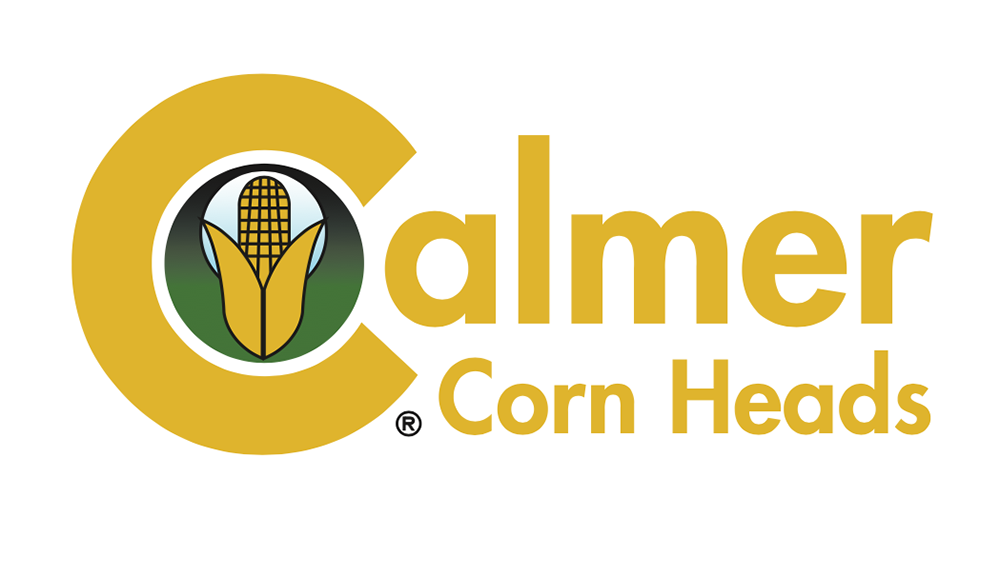
The No-Till Innovator Award program — sponsored by Calmer Corn Heads and No-Till Farmer — strives to honor farmers, researchers, businesses and services, and organizations for their work in assisting the growth of no-till practices, regardless of the types of crops or equipment used.
See the information below to learn about the 2022 honorees and click here to submit a No-Till Innovator Award Nomination for the 28th class of No-Till Innovators.
Nominate Those Worthy
The nomination process is already under way for the 28th class of No-Till Innovators, who will be recognized at the 32nd annual National No-Tillage Conference in the winter of 2024.
** The deadline for nominations for the 28th class of No-Till Innovators is Friday, June 23, 2023. There are four easy ways to submit a No-Till Innovator Award nomination:
- Submit your nomination form online here.
- Fax your completed nomination form to Michaela Paukner at (262) 786-5564.
- Email your completed nomination form to mpaukner@lessitermedia.com.
- Mail your completed nomination form to: No-Till Innovator Awards, Attn: Michaela Paukner, P.O. Box 624, Brookfield, WI 53008-0624.
The 2021 honorees are:
• Rick Clark — Williamsport, Ind., no-tiller, Crop Production
• Martin Industries — Elton, Ky., Business & Service
• Jon Anderson — Environmental scientist, Kentucky Department of Fish & Wildlife Resources, Research & Education
• South Dakota Soil Health Coalition — Jackson, Wis., Organization
NTIA Selection Committee
- Jim Hershey — Elizabethtown, Pa.
- Betsy Bower, Ceres Solutions — Lafayette, Ind.
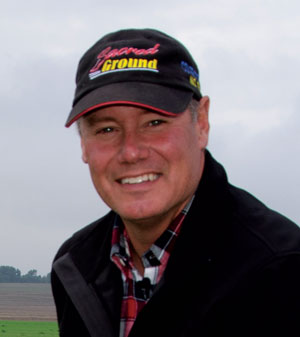
Rick Clark — Crop Production
You could say Rick Clark has become famous for being a quitter. Over the last 18 years, the Williamsport, Ind., no-tiller has quit using traditional farming techniques, including most synthetic inputs, on his 7,000-acre farm that is almost fully transitioned to organic practices.
He didn’t quit everything all at once, of course, and has taken cues from the land itself as he’s dropped old practices and picked up new ones to create the system he likes to call “regenerative organic stewardship with no tillage.”
That may be a mouthful, but farmers flock to his field days and his conference appearances not just to hear about what he’s doing and how he’s doing it, but also for the delivery. Clark exudes positivity and his enthusiasm for no-till, cover crops and integrating livestock is infectious. His message — that the challenge of getting outside one’s comfort zone is not only good for the land but also for personal growth — is hopeful and encouraging, and it’s shared with the humility of someone who has faced as many setbacks as he has successes.
Transitioning to new practices over the years — not to mention to an entirely different mindset — hasn’t been easy, and Clark will be the first to say so.
“We were some of the worst destructors of the soil in the county back in the day,” Clark says. “We would do the deep tillage, and if it didn’t turn the fields black and bury the residue, we did it again. It didn’t matter what the fuel costs were, it didn’t matter what the labor costs were, we just did it to do it.”
But seeing his fields erode onto the county highway after a spring rainstorm in the early 2000s got his attention and set him on his path to re-thinking his entire system.
“It hit me — it was time to make a change,” he says. But he realized he didn’t have a clue what to do or how to do it. So just like anyone else, Clark began his transition by researching the people and practices that were already successful.
Clark’s first practice change — aside from already having started no-tilling soybeans a few years before — was seeding 200 acres of a tillage radish cover crop that fall. “The reason I went with tillage radish is because it winter kills and I had no idea how to deal with that stuff in the spring,” he says. “We put out 6 pounds per acre, which is way too much, but of course I’m thinking if 2 pounds is good, then 6 pounds has got to be great.”
He laughs now, but the important thing is that it worked. The tillage radish flourished that fall and died in the winter, and the residue provided good weed suppression the following spring when he no-tilled corn into it.
“At the end of the year, this particular field wound up being the highest-yielding field on the farm,” he says. “I was hooked.”
“It’s very important that a farmer has success the first time they try this type of farming,” Clark adds. “If that cover crop doesn’t do what he expects it to do, I’m afraid he’s never going to come back to it. I had success, and that success led to where we are today.”
Clark ramped up his cover crop adoption and within 4 years was seeding the entire farm with covers. One of the most important practices he’s learned to implement has been using a roller-crimper to terminate cereal rye about 45 days after planting soybeans “green” into the cover crop.
“I’ve been blessed in many ways, and one of the ways I’ve been blessed is I’ve met the right people at the right time,” he says of his 2012 introduction to Erin Silva, who directs organic no-till research at the University of Wisconsin.
“Erin taught us how to plant soybeans into cereal rye at the boot stage and come back at anthesis and roll the mature rye down with a roller-crimper so the beans survive,” he says. “That was the beginning of my thought process on transitioning to organic no-till.
“This was also the beginning of reducing chemistry on the farm. It was the beginning of reducing fertility on the farm,” he says. “When you let the cover crops grow far into their maturity and you let them do what they were intended to do, then you reap the benefits of what that cover crop can do for you.”
While Clark has largely been successful with his adoption of organic no-till practices, he’s quick to point out that he’s had setbacks and has had to be nimble enough to move on to Plan B — if not C, D, E and beyond — when things didn’t work out.
He talks about wheat fields that didn’t yield well and the armyworm infestations that marched through his corn, wiping out acres of newly planted fields. He talks about mistakes he’s made, like the chicory he introduced onto his land for the cattle to graze on that he has not yet found a way to control.
But he’s philosophical about these experiences. “They’re not failures – they’re just outcomes we didn’t expect,” he says. “And that’s what we farmers need to hear. We can’t just always hear the good things — there are bad things happening here also.”
It’s easy to understand why farmers are inspired by Clark. He shares his challenges and his successes freely and is always pushing to take his land stewardship to the next level.
And he’s humble. He’s genuinely grateful for the community of like-minded farmers that he counts as friends. “I’m very thankful to be part of this group of regenerative farmers…it’s kind of a rare thing because they’re really looking out for everyone and it’s because they see the bigger picture,” he says. “It’s not just about what’s happening on this farm. It’s about what we can do across the whole farming industry.
“I’m absolutely honored to be the recipient of this year’s No-Till Innovator Award. I’m so thankful that what we’re trying to do is having an impact on other people and that people think what we’re doing has validity,” Clark adds. “This is a farmer-led movement and the people that are involved in this regenerative movement are so transparent about what’s going on and that’s what we need.”
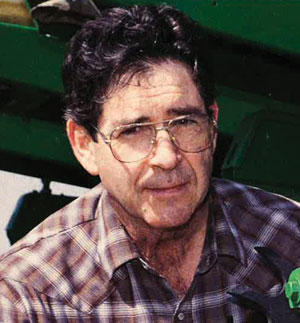
Martin Industries — Business & Service
Planter engineers have said more planting evolution has come out of western Kentucky than any other area in the U.S. Among those who have been pushing planter technology forward for decades is Martin Industries, the 2022 No-Till Farmer Innovator of the Year for Business & Service.
In the 1980s, Howard Martin of Elkton, Ky., began experimenting with a pair of rotary hoe wheels mounted to the front of a wheelbarrow, attempting to move residue in no-till fields without disturbing the soil.
This experiment became the first ground-driven rotary row cleaner, patented by Martin in 1988. His invention allowed soils to dry and warm faster for improved stands and more planting days for no-tillers. Martin Industries began manufacturing and selling the row cleaners in 1991 from Martin’s 30 x 36-foot farm shop.
“The timing could not have been better,” says Steve Martin, current president of Martin Industries and Howard’s son. “Changing government policies meant you could no longer till highly erodible land. This meant Kentucky’s highly erodible farmland could not be tilled and still qualify for programs.”
The company’s next innovation changed the way growers worldwide planted crops. The Martins designed the first spiked closing wheel with a rear rubber finishing wheel to use on planters. The spikes broke the sidewall compaction around the seed while loosely covering it with soil.
All of the pieces came together when a neighbor, Eugene Keeton, asked if the Martins would test the prototype of the Keeton seed firmer while they were planting. Some “partner dealers,” as Steve Martin calls them, later added drag chains and reduced inner diameter gauge wheels to the design.
“The partner dealers drove our designs, and in some cases, changed them from something that kind of worked to something that worked well,” Steve Martin says.
The combination of the row cleaners, Keeton seed firmer, reduced inner diameter gauge wheels, spading closing wheels and a drag chain became known as the Martin-Till Planting System.
The company continued to evolve in the following decades. The small farm shop is now a 48,000 square foot plant with a 1,500 square foot office. Martin Industries produced the first floating row cleaner in 1995, and later versions became the industry standard. The company even works with OEMs on new product development, such as an angle V-style closing update for the Case IH 2000 series in 2018.
“There’s no end to how much you can accomplish if you don’t mind who gets the credit,” Howard Martin says. “I always bragged on Mr. Keeton for being an encouragement and always bragged on Harry Young for being an inspiration. When I talked with people about the business, I’d find anybody that I could brag on except myself.”
Martin Industries remains deeply connected to no-till’s roots, and Steve Martin says their hearts are in making planters work better.
“We’re proud of our heritage in the evolution of no-till, and we hope to be here in another 30 years,” Steve Martin says.
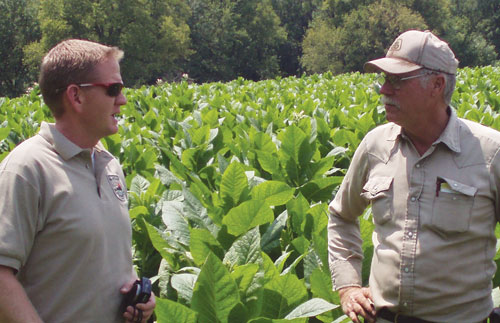
Jon Anderson (l), Bob James (r)
Jon Anderson — Educator
Jon Anderson, environmental scientist with the Kentucky Department of Fish & Wildlife Resources, has been the boots on the ground getting Kentucky tobacco producers to switch to no-till.
From 2012-2020, Anderson worked in a National Fish and Wildlife Foundation grant-funded position to implement no-till practices on Kentucky tobacco fields. The position opened at the perfect time for Anderson, who had gotten interested in improving soil health and adding cover crops on his own farm in 2012. He tested no-till on a field of corn silage and tried out cover crops that year with impressive results.
“About that same time, I heard about a job opening with KY Fish and Wildlife working with tobacco farmers, and it was a very unique position,” Anderson says. “It just sounded great because I love agriculture, and it gave me an opportunity to work in agriculture and improve wildlife conservation all at the same time.”
Through visits with farmers who were already no-tilling tobacco, tobacco trials and yield data collection, Anderson discovered no-till was a promising solution to soil erosion with similar — or better — yields compared to conventional tillage. Average yields for both no-till and conventional tillage for burley tobacco are 2,500 pounds per acre. Both methods average 3,200 pounds per acre for dark tobacco.
While some farmers were eager to try no-till after hearing about the research and yields, others were still skeptical. Anderson, along with coworker Brad Brown, used grant funds to purchase 6 new no-till tobacco setters from RJ Equipment in Canada and Checchi & Magli Company in Italy, giving producers the best equipment on the market to help make their first experiments with no-till a success.
“People were kind of quick to conclude,” Anderson says. “It seemed like if it didn’t prove instant results the first year, people would go back to their old way of growing conventionally. It’s understandable, but what we tried to do is encourage growers to give it a fair chance. If it didn’t work the first attempt, let’s figure out why and try again.”
Anderson says a good network of people brought together by the grant — including University of Kentucky tobacco specialists; Murray State University researchers; Altria tobacco company field reps; NRCS, UK Extension and Kentucky conservation district personnel; and members of the Council for Burley Tobacco and Burley Tobacco Growers Assn. — made it easy for him to find tobacco farmers to work with and offer them the knowledge and tools needed to be successful.
The word about no-till tobacco began to spread as Anderson held no-till tobacco field days, attended dozens of grower meetings, set up booths at trade shows and even started growing no-till tobacco on his own farm.
He also put in many long days and weekend hours to help producers plant a test plot, plant cover crops, do soil sampling and get answers to their questions. By the end of the grant program, Anderson and Brown worked with 328 Kentucky tobacco producers and ran 400-500 acres per year with the planters at the program’s peak.
Measurements and research from the no-till tobacco fields indicate that farmers who switched to no-till prevented 65-70% of their soil from eroding away. That’s an average of 6,832 tons of soil saved from installing no-till plots in 2016. No-tilling also improved water infiltration and soil structure in tobacco fields, and it reduced inputs by an average of $80 per acre.
“No-till tobacco can be grown efficiently and as well as conventional — it’s just you have to do it right,” Anderson says. “You need to be a good manager, follow an aggressive herbicide program, plan ahead and pick fields that are suitable.”
One additional positive result Anderson noted was a change in perception about no-till by the end of the 8-year grant.
“Tobacco is a very traditionally grown crop,” Anderson says. “The production methods have been unchanged for generations, and a lot of growers are reluctant to try something new. We had to break that barrier.
“We changed the mindset and proved no-till can work. Even the people who hadn’t tried it showed a future interest in it.”
Although the grant program is over, Anderson’s educational efforts continue. Tobacco growers and conservation groups in Connecticut, Pennsylvania and other states have asked him to speak about the project and its success in Kentucky. He and Brown shared some of the project’s early results with 2018 National No-Tillage Conference attendees from all over the country and world, too.

South Dakota Soil Health Coalition — Organization
As of 2 years ago, 50% of South Dakota growers are using no-till. The practice has been buoyed by no-tilling pioneers like Dwayne Beck and Dan Forgey. As the soil health benefits of no-tilling have become more widely known, South Dakota farmers have embraced the ideals and become quite progressive in their approach to educating other growers on no-tilling.
“There’s always a myth that no-till farming isn’t as profitable as conventional farming,” says Brian Johnson, a South Dakota Soil Health Coalition (SDSHC) board member from Frankfort, S.D. “We can prove differently with data.”
The SDSHC hosts an annual conference each winter and a soil health school each summer as part of their flagship educational efforts. Field tours are held during the year to connect growers on a local level with a more seasoned grower who has already been utilizing no-till, cover crops and livestock integration.
“We’re just another tool in the toolbox for producers,” Johnson adds. “It’s a great way for us to help educate producers and improve the quality of soil here in South Dakota.”
SDSHC board member Doug Sieck, Selby, S.D., says the organization uses a formula where an expert discusses a topic, followed by a grower who has been using that practice to reinforce the message.
“Our main goal is to teach people how to do things to better the soil, and when they go home and use it, then your neighbor sees it,” says Forgey. “We’re gaining every year.”
In 2016, the SDSHC hosted its first soil health school near Roscoe, S.D. The SDSHC purposely limits attendance to 30 participants to encourage relationship building amongst the attendees. The soil health school moves to a different part of the state every 2 years. So far, six soil health schools have been held in three different locations.
“For a new person, that can be kind of daunting when you hear about these new practices, but we’re willing to help answer those questions and hopefully avoid those mistakes,” Johnson says.
The organization will soon launch a mentor app that will allow producers to connect with other producers who have experience with soil health management practices.
“That’s a huge deal because a lot of these things we’re doing with soil health can be a bit precarious,” says Sieck. “There can be some fear involved. Things like the mentoring app can help you connect with people who are also doing these things so we can help increase your chances of success.”
A grazing exchange hosted by the SDSHC helps livestock producers identify growers who might have land available for them to graze their animals. The idea has been so successful that other states are signing onto the exchange, according to Johnson.
“We’re getting livestock on cropland where they weren’t before,” adds Sieck.
Technology has allowed the SDSHC to share their message beyond state borders. Sieck shares an example of one of their conference attendees.
“He said he’d been watching our YouTube videos all winter about soil health, and then came to our soil health conference to see it in person,” Sieck says.
The coalition has also hosted soil health sitdowns and informal get-togethers for growers to network and discuss soil health topics.
“We go around the room and share what we’ve been doing, and share ideas back and forth,” Sieck says.
SDSHC members run the gamut, from those who have just cropland to those who just have livestock and graze, and everything in between.
In the short-term, the organization plans to continue sharing the message that reducing tillage, livestock integration and cover crops are a great way to take care of the land while also being profitable.
Over the long-term, the SDSHC will continue showing that having livestock on cropland is sustainable and an excellent way to produce protein.
“As you see the supply chain issues throughout the country right now, we can’t always rely on these huge meat-packing plants for protein production,” Johnson says. “You can get protein from your local producer who has beef, pork, lamb, whatever you want. We also need to support the small lockers in the country because they have a really close connection between producers and consumers.”
The SDSHC is also considering buying a small piece of land where there can be demonstration plots, tours hosted, and other activities, Sieck says.
No-tillers can’t expect consumers to understand what they’re doing on the farm intiutively, Johnson says.
“We need to share why no-till is positive, why it’s better for the environment, and keep reaching consumers so they understand what agriculture is,” he says. “We’re actually raising food in a healthy way that’s climate friendly.”
Technology is changing so fast, it’s difficult to predict what the future holds, Johnson says.
“I think it’s going to be much more site-specific and more electronic,” Johnson says. “We have so many more tools available to us today with no-till, because we’ve figured out what works best.”
Sieck adds that the coalition is exploring other communication mediums like podcasts and other technologies to share their message.
Although the future remains uncertain, what is definite is that the SDSHC will be there, helping no-till thrive in South Dakota and beyond.
“We’re not done. We still need to reach many more people who want to make these changes,” says Johnson. “Improving soil health is a lifelong commitment and the practices we put in place today will make it much more sustainable and profitable in the long run.”
Past Recipients
Crop Production
1996 — John McLarty, London, Ontario
1997 — Ron Jaques, Hutchinson, Kan.
1998 — Steve Groff, Holtwood, Pa.
1999 — Doug Harford*, Mazon, Ill.
2000 — Mike Ellis, Worth & Dee Ellis Farm, Eminence, Ky.
2001 — Russ Zenner, Genesee, Idaho
2002 — Mike, Ted, Paul, Tom and Nick Guetterman, Bucyrus, Kan.
2003 — Tom, Jeff and Doug Martin, Mt. Pulaski, Ill.
2004 — Randy Schwartz, Great Bend, Kan.
2005 — John Aeschliman, Colfax, Wash.
2006 — Joe Breker, Havana, N.D.
2007 — Bill Richards, Circleville, Ohio
2008 — Allen Berry, Nauvoo, Ill.
2009 — Rulon Enterprises (Rodney, Ken and Roy Rulon), Arcadia, Ind.
2010 — Ray McCormick, Vincennes, Ind.
2011 — Terry Taylor, Geff, Ill.
2012 — Dan DeSutter, Attica, Ind.
2013 — Jack Maloney, Brownsburg, Ind.
2014 — Mike Beer, Keldron, S.D.
2015 — David Brandt, Carroll, Ohio
2016 — Steve Berger, Wellman, Iowa
2017 — Annie Dee, Aliceville, Ala.
2018 — Jim Hershey, Elizabethtown, Pa.
2019 — Ralph Upton Jr., Springerton, Ill.
2020 — Loran Steinlage, West Union, Iowa
2021 — Rick Clark, Williamsport, Ind.
Research & Education
1996 — John Bradley, University of Tennessee, Milan, Tenn.
1997 — George Kapusta*, Southern Illinois University, Carbondale, Ill.
1998 — Paul Jasa, University of Nebraska, Lincoln, Neb.
1999 — Dwayne Beck, Dakota Lakes Research Farm, Pierre, S.D.
2000 — John Walker, Ricks College, Rexburg, Idaho
2001 — Wayne Reeves, National Soils Lab, Agricultural Research Service, U.S. Department of Agriculture, Auburn, Ala.
2002 — Glover Triplett, Mississippi State University, Starkville, Miss.
2003 — Norman Widman, Natural Resources Conservation Service, Columbus, Ohio
2004 — Dan Towery, Conservation Technology Information Center, West Lafayette, Ind.
2005 — Jim Cook, Washington State University, Pullman, Wash.
2006 — Jim Leverich, University of Wisconsin Cooperative Extension Service, Sparta, Wis.
2007 — Bud Davis, Natural Resources Conservation Service, Salina, Kan.
2008 — Randy Raper, National Soil Dynamics Lab, Agricultural Research Service, U.S. Department of Agriculture, Auburn, Ala.
2009 — Barry Fisher, Indiana NRCS state agronomist, Indianapolis, Ind.
2010 — Harold Reetz, Reetz Agronomic Services, Monticello, Ill.
2011 — Randall Reeder, Ohio State University, Columbus, Ohio.
2012 — Randy Pryor, University of Nebraska Extension
2013 — Jill Clapperton, Rhizoterra, Inc., Florence, Mont.
2014 — Joel Gruver, Western Illinois University, Macomb, Ill.
2015 — Dr. Lloyd Murdock, University of Kentucky, Princeton, Ky.
2016 — Dave Franzen, North Dakota State University, Fargo, N.D.
2017 — Hans Kok, ag conservation consultant, Indianapolis, Ind.
2018 — Eileen Kladivko, Purdue University
2019 — Jim Hoorman, retired NRCS, Ohio State Extension educator
2020 — Jeffrey Mitchell, Cooperative Extension specialist, University of California-Davis
2021 — Jon Anderson, Environmental scientist, Kentucky Department of Fish & Wildlife Resources
Business and Service
1996 — Swaim Crop Consulting, Crawfordsville, Ind.
1997 — Southern States Cooperative, Owensboro, Ky.
1998 — Nester Ag Management, Antwerp, Ohio
1999 — Hymark Consulting, Blanchester, Ohio
2000 — Savage Crop Consulting, Farley, Iowa
2001 — ITAC Inc., Prairie du Sac, Wis.
2002 —
Whitehall Agricultural Services, Whitehall, Wis.
2003 — Moeller Ag Service, Keokuk, Iowa
2004 — Exactrix Inc., Spokane, Wash.
2005 — Schaffert Manufacturing, Indianola, Neb.
2006 — Kroeck Consulting, Knoxville, Pa.
2007 — Binkley & Hurst, Lititz, Pa.
2008 — Progressive Farm Products, Hudson, Ill.
2009 — Brokaw Supply Co., Fort Dodge, Iowa
2010 — Great Plains Mfg., Salina, Kan.
2011 — J.A. Scott Farms Inc., Pierceton, Ind.
2012 — Advanced Ag Solutions, Lafayette, Ind.
2013 — Precision Agri Services, Inc., Minster, Ohio
2014 — Ag Spectrum, DeWitt, Iowa
2015 — Needham Ag Technologies, Calhoun, Ky.
2016 — Ceres Solutions, Lafayette, Ind.
2017 — Cross Slot USA, Missoula, Mont.
2018 — Vertical Till Injector, Washington, Iowa
2019 — Ward Laboratories, Kearney, Neb.
2020 — Exapta Solutions, Salina, Kan.
2021 – Martin Industries, Elkton, Ky. 2021
No-Till Organizations
1997 — Manitoba-North Dakota Zero Tillage Farmer’s Association, Brandon, Manitoba
1998 — Clark County Farm Bureau,
Clark County, Ind.
1999 —
Conservation Action Project,
Defiance, Ohio
2000 — Ohio No-Till Council, Columbus, Ohio
2001 — Coffee County Conservation Tillage Alliance, Coffee County, Ga.
2002 — West Tennessee No-Till Farmers Association, Milan, Tenn.
2003 — Pacific Northwest Direct Seed Association, Pullman, Wash.
2004 — Lower Elkhorn Natural Resource District, Norfolk, Neb.
2005 — Innovative Farmers Association of Port
Stanley, Ontario
2006 — Innovative Cropping Systems Team, Quinton, Va.
2007 — Clearwater Direct Seeders, Idaho
2008 — Embarras River Management Association, Toledo, Ill.
2009 — No-Till on the Plains, Salina, Kan.
2010 — Delta Conservation Demonstration Center, Metcalfe, Miss.
2011 — Pennsylvania No-Till Alliance
2012 — Midwest Cover Crops Council
2013 — Virginia No-Till Alliance
2014 — Ohio Conservation Tillage Conference
2015 — Conservation Cropping Systems Initiative
2016 — Champlain Valley Farmer Coalition, Middlesbury, Vt.
2017 — Conservation Agriculture Systems Innovation Center, Parlier Calif.
2018 —
Colorado Conservation Tillage Association, Burlington, Colo.
2019 — South Dakota No-Till Association, Pierre, S.D.
2020 — Practical Farmers of Iowa, Ames, Iowa
2021 — South Dakota Soil Health Coalition, Pierre, S.D.
Equipment Design
1996 — Howard Martin, Elkton, Ky.
1997 — Ray Rawson, Farwell, Mich.
1998 — Eugene Keeton*, Clarksville, Tenn.
1999 — Jon Kinzenbaw, Kinze Manufacturing Co., Williamsburg, Iowa
2000 — Terry Schneider, Shirley, Ill.
2001 — The Reed Family (Paul Reed), Washington, Iowa
2002 — Herb Stam*, Hi-Pro Manufacturing Co., Watseka, Ill.
Ag Supplier
1997 — Jim and Tom Boyd, B & B Farm Service, Fredericktown, Ohio
1998 — Eric Laux, Laux Farm Service, New Madison, Ohio
1999 — Crop Production Services, Morganfield, Ky.
2000 — Miles Farm Supply and Opti-Crop, Owensboro, Ky.
2001 — Roger Strand, Strand of Milan, Inc., Milan, Minn.
2002 — Loudonville Farmers Equity, Loudonville, Ohio
Environmental Stewardship
1996 — Jim LeCureux, Bad Axe, Mich.
Public Image of Agriculture
1996 — Marion Calmer, Alpha, Ill.
Education
1996 — Mike Plumer*, Marion, Ill.
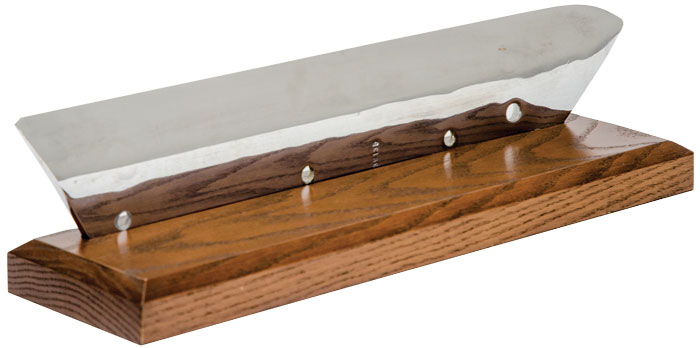
No-Till Farmer’s Original Awards: The Repurposed Plowshare
In the early days of promoting no-till, No-Till Farmer honored outstanding no-till growers and educators who were researching and promoting reduced tillage with a special “Plowshare Award.” This was the publication's highest awards prior to the launch of the No-Till Innovator Awards in 1996.
For those who have never plowed, a hardened steel plowshare represents the cutting or leading edge on the bottom of the moldboard that slices through the ground. The sliced dirt is then turned over by the moldboard.
Mounted on a wooden base, the chrome-plated plowshares were chosen for the award to symbolize the end of the plowing era. From 1973 to 1981, 25 no-till farmers, educators and pioneers were presented with these plowshare awards.
Plus, the plowshares gave new life to an item that wasn’t going to enjoy as much demand in the future.
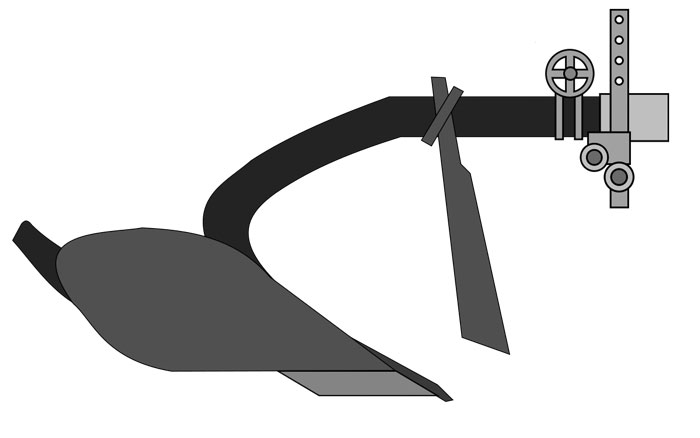
SLICING DIRT. A hardened steel plowshare serves as the cutting edge along the bottom of the moldboard. The fresh sliced soil is then turned over by the moldboard as the plow travels through the field.
When one of our staff would go to a farm equipment dealership to buy the plowshares, the parts counter man would always ask what make and model plow we needed. He always looked surprised when we told him it didn‘t matter.
After explaining what we had in mind and seeing the look of surprise on the parts guy’s face, we’d take the plowshares to a Milwaukee chrome plater to add the silver color.
The honored educators and growers usually found a place for these unusual plowshare awards on their desks. And I’m sure the special plaques sparked many a conversation as to what the awards represented in an era where the number of plowed acres were being dramatically reduced.
Excerpted from From Maverick to Mainstream: A History of No-Till Farming
25 Award Recipients (1973-1981)
1973
-
Harry Young, Jr.*
Herndon, Ky. -
Shirley Phillips*
University of Kentucky, Lexington, Ky.
1974
-
Ralph Rasnic*
Riner, Va. -
George McKibben*
Dixon Springs, Agricultural Center, Simpson, Ill. -
W.W. Moschler* & G. Myron Shear*
Virginia Tech, Blacksburg, Va.
1975
-
Ernie Behn*
Boone, Iowa, -
Glover Triplett, Jr.
Ohio State University, Wooster, Ohio -
Keith Barrons*
Dow Chemical Co., Midland, Mich.
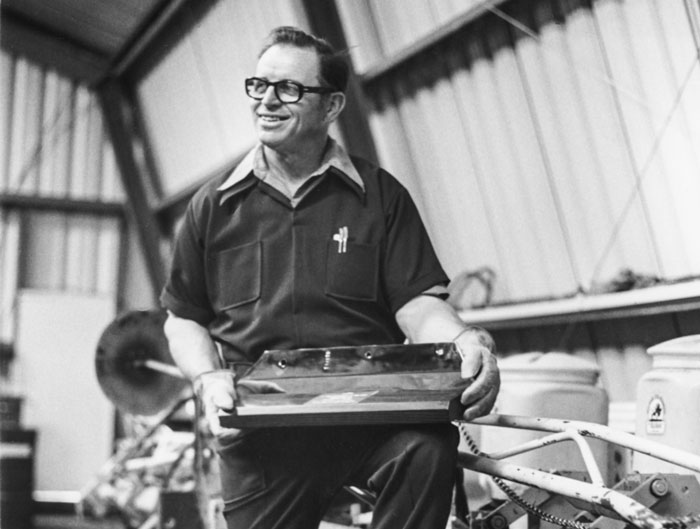
Ernie Behn
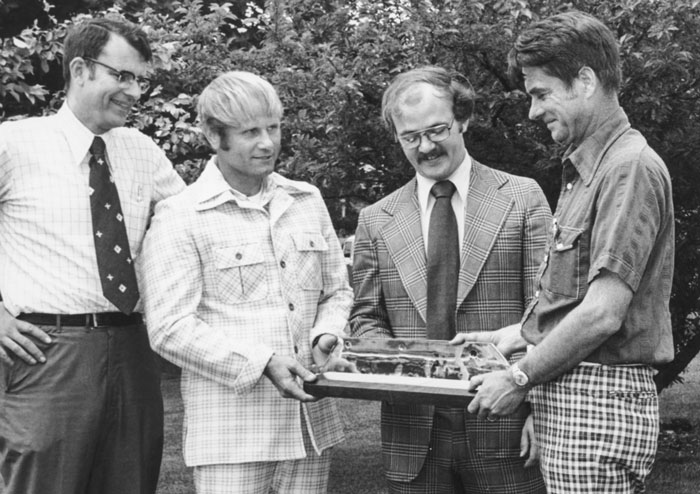
Glover Triplett
1976
-
Bob Stewart
Jewett, Ohio -
Joe Newcomer*
University of Maryland, College Park, Md. -
Milton Sprague
Rutgers University, New Brunswick, N.J.
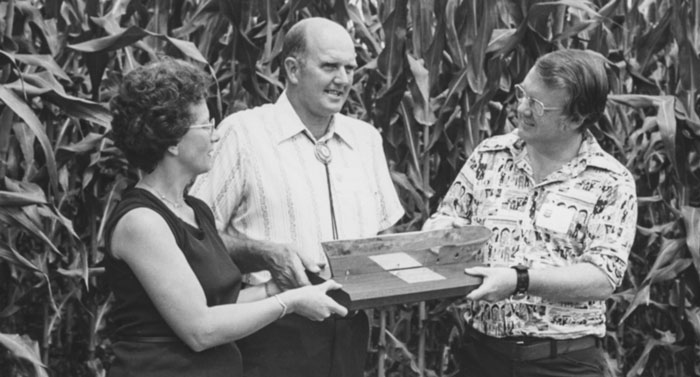
Bob Stewart
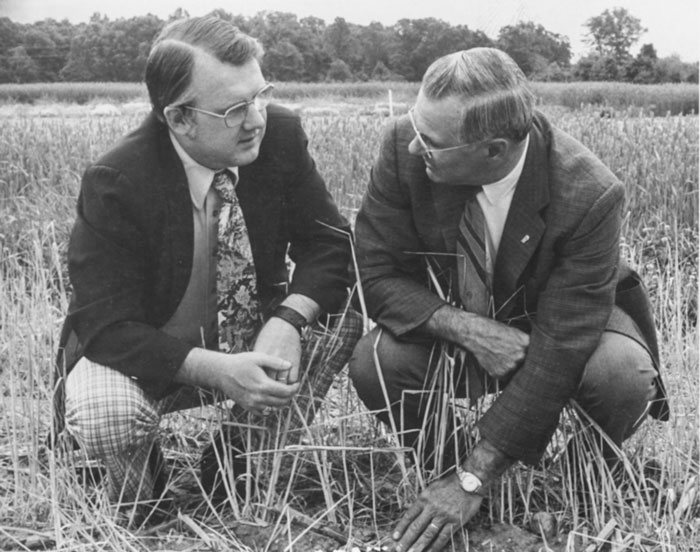
Joe Newcomer
1977
-
Paul Schaffert
Indianola, Neb. -
Bill Lewis
North Carolina State University, Raleigh, N.C. -
Walt Buescher*
Allis-Chalmers, West Allis, Wis.
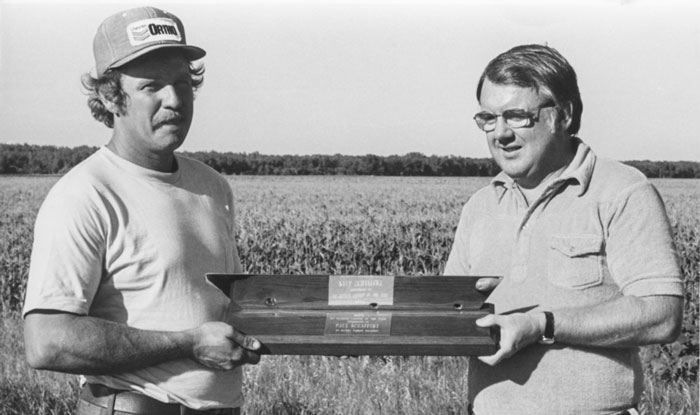
Paul Schaffert
1978
-
Jerrell & Leo Harden
Banks, Ala. -
Allen Wiese
Texas A&M Agricultural Research and Education Center, Amarillo, Texas -
C.M. Woodruff*
University of Missouri, Columbia, Mo.
1979
-
Neil Springer
Mount Vernon, Ohio -
Gail Wicks
University of Nebraska, North Platte, Neb. -
Harold Lloyd*
USDA North Appalachian Experimental Watershed Station, Coshocton, Ohio
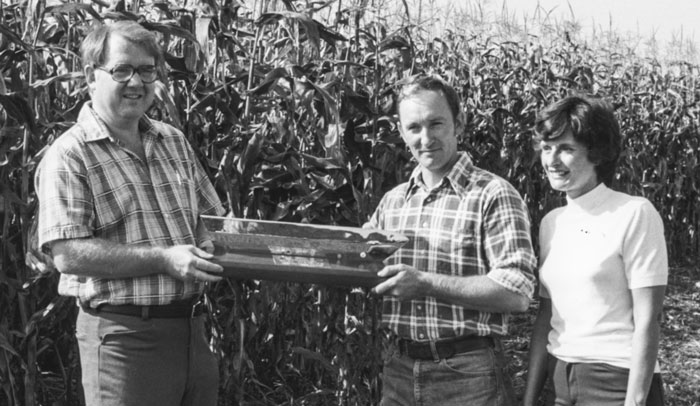
Neil Springer
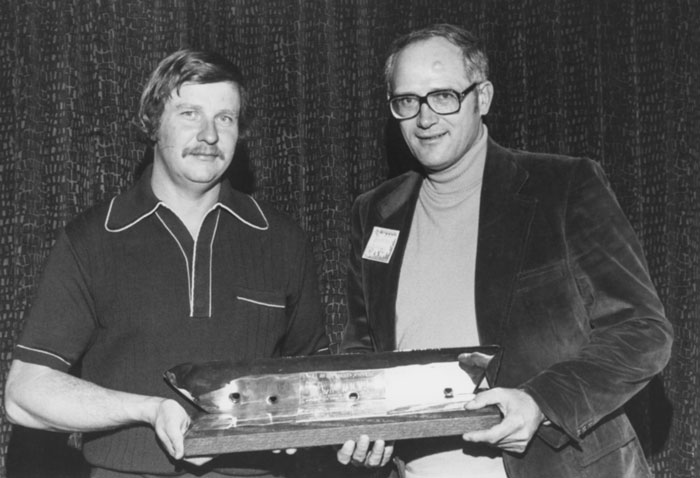
Gail Wicks
1980
-
Ken Rehm*
Kirkland, Ill. -
Raymond Gallagher
University of Florida, Gainesville, Fla. -
J.N. Jones
Virginia Polytechnic Institute, Blacksburg, Va.
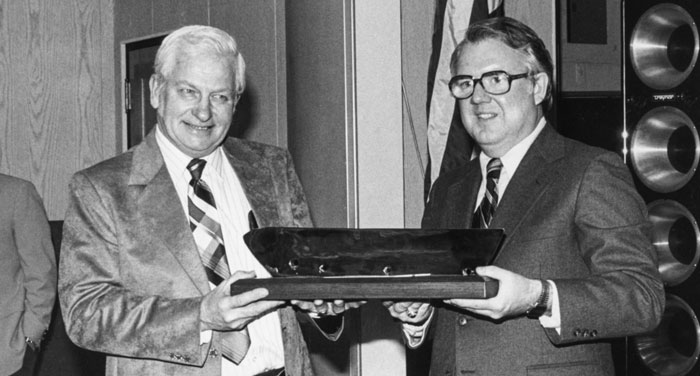
Ken Rehm
1981
-
Jim McCutcheon*
Homewood, Manitoba
*Deceased








Post a comment
Report Abusive Comment